

Te Mata Estate Coleraine 2022
Style: Red Wine
Closure: Cork
Te Mata Estate Coleraine 2022
Warehouse
34 Redland Drive
Vermont VIC 3133
Australia
Critic Score: 99
Alcohol: 13.5%
Size: 750 ml
Drink by: 2050
Te Mata Estate was acquired by John Buck in 1974 and the Buck family have been producing Te Mata wines ever since. Coleraine is named after John's family ancestral hometown in Northern Ireland. Coleraine is Te Mata Estate's flagship wine and is regarded by many as New Zealand's finest red wine. First produced in 1982, Coleraine is a classic blend of cabernet sauvignon, merlot and cabernet franc.
"The 'King of the Grape' Cabernet Sauvignon comes to the fore with its flatteringly classy presence. This is captivating and totally seductive on the nose, exhibiting blackcurrant, violet, game, anise, subtle tobacco and cedary oak characters, leading to a powerfully concentrated palate displaying considerable depth and exceptional concentration. Harmonious too, it’s gloriously structured and balanced with a firm grip, yet the tannins are just right and seamlessly infused. Perfectly proportioned." Sam Kim
The 2022 comprises 84% cabernet sauvignon, 13% merlot and 3% cabernet franc. This is the highest level of Cabernet Sauvignon in the blend since the first release in 1982, and as a result, the 2022 is a more Cabernet-focused expression of Coleraine.
"If the Langton's Classification crossed the Tasman, Te Mata Coleraine would sit alongside Grange at its very pinnacle. Established, esteemed, outstanding – vintage after vintage, the glowing adjectives come thick and fast." Langtons
"Coleraine ’22 harnesses the energy and complexity of Te Mata cabernet sauvignon, on show at its highest level since the first Coleraine in 1982. The beautiful floral aromas of lavender, violet, plum and blackcurrant, are all in orbit around the wine’s dark savoury core of tightly wound graphite, nori, coffee grounds, vanilla and tobacco. The palate is intensely concentrated, with a superbright tension building freshness and precision as layer upon layer of fine polished tannins give pinpoint detail alongside signature, exacting, levels of finesse." Te Mata Estate
Te Mata Estate Winery
Expert reviews
"Deep, brooding purple-red colour with a concentrated berry fruit bouquet laced with cedar, violets and dried herbs, gorgeous fruit and classy oak embellishment. The wine is full bodied and powerful, with a generous serving of fine grained tannins that add length, authority and a drying but supple finish. Tremendous persistence and wonderful structure. A great wine, that will richly reward long-term cellaring. Drink: 2026–2044." Huon Hooke, The Real Review - 99 points
"The 'King of the Grape' Cabernet Sauvignon comes to the fore with its flatteringly classy presence. This is captivating and totally seductive on the nose, exhibiting blackcurrant, violet, game, anise, subtle tobacco and cedary oak characters, leading to a powerfully concentrated palate displaying considerable depth and exceptional concentration. Harmonious too, it’s gloriously structured and balanced with a firm grip, yet the tannins are just right and seamlessly infused. Perfectly proportioned, this 2022 has the majestic feel that each previous Coleraine possesses. Date: Jan 2024; At its best: 2032 to 2052." Sam Kim, Wine Orbit – 98 points
"The 2022 Coleraine is laden at this stage with the outrageous attractiveness of youth. I mean, it's irresistible. There's raspberry, nori, rose petals, coffee grounds, star anise, salted licorice, sun-dried kelp/nori, warm pine (I know this smell because I was hiking around the Te Mata peak yesterday, and there was a fallen pine tree lying in the sun, and it smelled great) and layers of peppercorns. In the mouth, the wine is so fresh, so alive, with so much energy, but it already is showing the svelte line of this house, this place. With a hint of raw cocoa laced through the finish, I'm sad to push this glass away. It will be the last time that I taste it for a while. A ripper. Excellent. This is composed of 84% Cabernet Sauvignon, 13% Merlot, 3% Cabernet Franc. Drink: 2023-2057." Erin Larkin, Wine Advocate - 97+ points
"Oak is a little obvious but it is attractive oak and should integrate into the wine in time (it was bottled six weeks before tasting). Cassis, cedar, floral and tobacco flavours are evident. Youthful wine that clearly needs time. Elegant red that seems to get better every vintage. Drink: 2024–2037." Bob Campbell MW, The Real Review - 97 points
"A very elegant young Coleraine with lovely aromas of oyster shell, lead pencil, sweet tobacco, black currant and moss. Very perfumed and expressive. Medium-bodied with fine tannins that are polished and energetic with some citrusy acidity underneath. Some dust to the texture. This is the second highest blend of cabernet sauvignon in the history of Coleraine with 84% cabernet sauvignon, 13% merlot and the rest cabernet franc. March release. Best after 2027 and beyond." James Suckling, JamesSuckling.com - 96 points
"Whoa, so fresh, such beautiful perfume, floral, lavender and violets, touches of cassis, some woody spices, so lifted and frisky. Three days in mind you. White pepper, plum, faint choc-mint in there too. Scents for days. So fine, so silky, choc-liquorice, cassis strongly in the palate, blueberry, grunt of dried herbs and some truffle notes. Concentrated but so fresh in the same breath. Tannins all graphite and slate, wonderfully minerally. Beautiful." Mike Bennie, The Wine Front - 96 points
"Very small berries in 2022, with crops about 40% down on average. I tasted this over two days, and gee, it really moved about. Started off with a pop of fragrance and more rugged tannin, then it eased itself back into a more typical Coleraine profile, though for sure it’s a different style in some respects with its unusually high Cabernet Sauvignon component of 84%, the remainder being 13% Merlot and 3% Cabernet Franc.
Black fruit, some red, pencil lead, a little aniseed and floral perfume, nori, baking spice, pimento, slight vanilla. Medium-bodied, a fair bit of chew, dark fruit and dark chocolate, porcini mushroom umami, grainy tannin, concentrated and chewy, earthy and ferrous, with a bright line of very ‘mineral’ acidity on a long finish. Excellent, albeit a more Cabernet focussed expression of Coleraine, which marks it out as being different, and on that point such a worthy of addition to the cellar, though of course the wine is outstanding irrespective of that. Tasted: Dec 2023; Alcohol: 13.5%; Closure: Cork; Drink: 2027-2046+." Gary Walsh, The Wine Front - 96 points
The story of coleraine

Te Mata Estate was acquired by John Buck in 1974 and the Buck family have been producing Te Mata wines ever since. Coleraine is named after John's family ancestral hometown in Northern Ireland.
"Coleraine is New Zealand's greatest red wine" - Sydney Morning Herald
Coleraine is Te Mata Estate's flagship wine and is regarded by many as New Zealand's finest red wine. First produced in 1982, Coleraine is a classic blend of cabernet sauvignon, merlot and cabernet franc, and displays the concentration, complexity and elegance found in the world's greatest wines. Coleraine showed the world that Hawke's Bay, and indeed New Zealand, was capable of making world class red blends.
Cabernet Sauvignon is nearly always the dominant grape variety but the blend has ranged from 94% Cabernet Sauvignon in 1982 down to just 25% in 2002. The remainder of the blend is predominantly Merlot with, usually, the addition of small amounts of Cabernet Franc.
The earlier vintages of Coleraine from 1982 to 1988 were all single-vineyard blends from the Coleraine vineyard. From 1989 onwards, the wine has been a blend of grapes from across the Te Mata Estate vineyards that were planted in 1982.
Peter Cowley joined Te Mata as their sole winemaker in 1984, two years after Coleraine's inaugural vintage. He has been responsible for all the subsequent vintages until his retirement in 2019. Peter handed over the reins to now senior winemaker Philip Brodie, who has been part of the Te Mata Estate team since 1992.
"The absolute strength of Bordeaux blends is in different varieties and different soils, and that's where we started. But it is also really about the people that put these wines together, who made them what they are.
Although it might have been inspired by Bordeaux, the thing about Coleraine is that it has really come out of that shadow and it has developed its own voice and style in that time. When you go through 32 years of Coleraine, we are looking at New Zealand history – we are stepping out of the shadow of Bordeaux and taking pride in New Zealand." Toby Buck, Te Mata Estate
Nick Buck discusses Coleraine
About the winery

Te Mata Estate was established in 1896, specialising in high-quality wines of classical style. The winery remains family owned, producing internationally recognized wines exclusively from its Hawke's Bay vineyards.
"New Zealand's first growth" - Andy Howard MW, Decanter Magazine
"A national treasure" - Jancis Robinson MW
"New Zealand's greatest winery" - Robert Parker's Wine Advocate
Te Mata Estate was originally part of Te Mata Station, a large pastoral land-holding established by English immigrant, John Chambers, in 1854. After returning from France, John Chamber's third son, Bernard, had the idea to plant vineyards on the north-facing hills around Havelock North. In 1892 he planted vines on three parcels of hillside land above the homestead and began converting the original stables to ferment and mature the wines. The first vintage wines were released in 1986. Today, Te Mata Estate still uses those same three vineyards.
The Chambers family sold the property in 1919. The property had two other owners until John and Wendy Buck acquired Te Mata Estate in 1978 and instigated a twenty-year development program, which commenced with the restoration of the original winery building and the replanting of all of the original vineyards. In addition, new vineyard sites were acquired in the Bridge Pa, Gimblett Gravels and Dartmoor Valley sub-regions of Hawke's Bay (refer map below). The Buck family have been producing Te Mata wines ever since. The success of Te Mata's wines in the '80s is credited with sparking the revival of Hawke's Bay as a top wine region.

Te Mata Estate Winery and Hawke's Bay sub-regions

New Zealand
New Zealand is home to more than 700 wineries across 14 wine regions. The regions are Auckland, Bay of Plenty, Canterbury, Central Otago, Gisborne, Hawkes Bay, Marlborough, Martinborough*, Nelson, Northland, Waikato, Waipara Valley, Wairarapa and Waitaki Valley. * Martinborough is a sub-region of Wairarapa, however, as it is world renowned it is considered here to be a region to avoid confusion.
The wine regions in New Zealand stretch from latitudes 36°S (Northland) in the north (comparable in latitude to Jerez, Spain), to 45°S (Central Otago) in the south (comparable in latitude to Bordeaux, France). New Zealand's climate is maritime, producing cooler summers and milder winters than would be expected at similar latitudes in Europe.
Viticulture in New Zealand dates back to 1836 when British resident James Busby produced wine in the far north, but it wasn't until 1985 that the wine industry came of age when Cloudy Bay Sauvignon Blanc garnered international attention and critical acclaim.
New Zealand is internationally renowned for Sauvignon Blanc (particularly from Marlborough), Pinot Noir (Central Otago, Martinborough and Waipara Valley), Chardonnay, Bordeaux-style blends of mainly Merlot and Cabernet Sauvignon (Hawkes Bay) and Syrah (Hawkes Bay). Sauvignon Blanc accounts for 63% of the area of the national vineyard, followed by Pinot Noir (14%), Chardonnay (8%), Pinot Gris (7%) and Merlot (3%).



